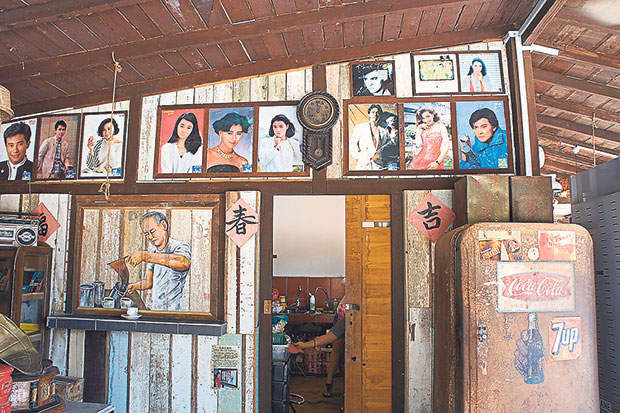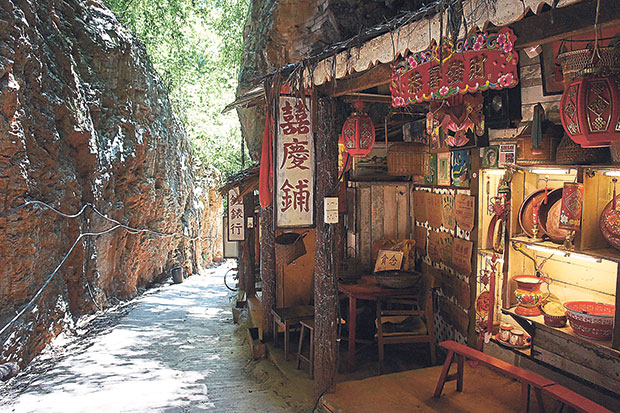IPOH, July 24 — The drive will take you through housing estates and towards the limestone hill range that looms in the background. Make your way in from the car park and you will see a signboard indicating the place as a Buddhist centre, while an “Entrance” plaque hangs above what looks like a makeshift walkway where you will be waved in.
Just as you think entrance is free, you notice a wooden village house painted a striking green where someone is waiting out front to exchange your ringgit for admission tickets.

Confusing, random and eclectic — this pretty much sums up Qing Xin Ling Leisure & Cultural Village, sandwiched between two famous cave temples (Sam Poh Tong and Kek Lok Tong) in Gunung Rapat, about 20 minutes from Ipoh. It has been pulling the crowds for about two years now and visitors have nicknamed it Little Guilin, after one of China’s most picturesque destinations.
Its name, after all, means Serene Village in Chinese and it meets all the requirements needed to be one, with limestone hills surrounding a striking green lake.

In essence, Qing Xin Ling is a nostalgic showcase that aims to capture the charming days of yore, set within a natural environment that is the pride of Ipoh. There are no major activities or landmarks; it is simply a place to relax and take in the view. What it does offer in spades though are photo opportunities, especially if you have a penchant for vintage aesthetics.
There’s a lot to take in at first look; dotted around the premises are a number of traditional wooden buildings while specks of bold colours stand out at various corners.

You will come across the chalets first, painted in bold monotones and facing the lake, that are open to staying guests. The facades serve as canvases for a series of 2D and 3D murals conceived by Teluk Intan-based artist Lee Tio Chon.

Besides philosophical sayings, the artworks also pay homage to traditional Malaysian food trades such as satay, teh tarik and Hainanese coffee.

An oversized statue of the God of Prosperity stands in the shade of a tree, the branches dripping with red ribbon strips onto which visitors write their wishes which they then hang as blessings. Behind him is a food court of sorts, where stalls focus on favourite local eats, although most tend to be closed on weekdays.

You will see bicycles, tricycles and other manual modes of transport scattered around. These rides are provided free for visitors, and they range from regular bicycles to tandem vehicles and even the traditional Chinese rickshaw.
Walking is probably a better way to get around though, as the paths are gravelly. Besides, as the rides are all free, once you leave yours unattended, someone will come along and take it for a spin.

Some areas are off-limits to bicycles anyway, like the periphery of the lake that encircles the Pirate’s Ship — random as Qing Xin Ling may be, this really appears quite out of place but it’s a good spot to seek respite in air-conditioned comfort while observing more 3D art.
On a fair weather afternoon, take a walk around and if you happen to be visiting on a quiet day, you will sense an Amazonian vibe to the place, what with craggy geological formations towering above and thick greens all around.

At the opposite end from the ship, a decidedly old world feel prevails. There are murals, painted on the stones, that depict the pioneering trades that Ipoh was built on such as tin mining and rubber tapping.
The humble pomelo, most famously associated with nearby Tambun, is also featured here. Snuggled in between a deep crevice is another odd scene, of cut-out figures of cave men stirring a cauldron over a fire.

Walk back to the other side of the lake and the Stone Age mood is replaced by a 70s Oriental one. Under the low roof of a limestone hill, vintage collectibles are scattered like random decor items, surrounding a gold statue of the Goddess Kuan Yin.
Some are neatly arranged inside lit-up glass cabinets, forming a mini museum. These apparently are the owner’s own prized collection that he amassed over the years and none are for sale.

You can also sit down for a 15-minute vigorous head and shoulder massage with a pay-as-you-wish concept while classic Chinese songs blare from the jukeboxes behind.

Or get refreshed with a cold drink at the retro-fitted cafe, fronted by a rusted refrigerator, and framed photographs of veteran Hong Kong actors on the feature wall behind it.

Once recharged, you can then make your way up the stairs to the back of the hill where more random vintage scenes await. A red English phone booth lines up next to a resting pavilion, a stall selling message cards that you can pen your wishes on and tag onto the facing wall — like a toned down version of lovers’ locks bridges — and an old shaved ice dessert stall.

Keep walking and more of such kiosks and old shops lie along the winding uphill path paved with stones. Altogether, the scenario resembles an ancient village, like the kind you might have seen in Chinese period dramas except that the shops have a decidedly Malaysian flavour.

Cendol and wantan noodles stalls neighbour a barber and a clock shop, each fronted by a handwritten Chinese signboard. Each is decked out fully in the essentials as well as decorative items and there is a certain authenticity to the displays.
At the top of this small hill is a mock rubber tapper’s hut, complete with an outhouse. And that is where the retro Malaysian flavour ends and the pre-historic flair returns: A pair of dinosaur statues sit entwined in a clearing facing the hut, under a tiny waterfall that trickles over the rocks and leafy greens.

All in all, the Qing Xin Ling experience is a little messy, a little kitschy, and a whole lot of eccentric. It’s certainly not like most other attractions in Ipoh or its vicinity, and you may leave feeling more confused than when you first stepped in.
But if you’re looking for an easy way to fill an hour or two of your time and gather some nostalgic fodder for your social media feeds, go with an open mind and just enjoy the place for what it is — a throwback to the way things were.
Qing Xin Ling Leisure & Culture Village
22A Persiaran Pinggir Rapat 5A, Taman Saikat, 31350 Ipoh, Perak
Opens 10am-5.30pm daily; may be closed on certain holidays, check their Facebook page for updates
Admission RM6 per adult, free for children www.facebook.com/qingxinlingipoh
A Perak native, Vivian Chong enjoys discovering the hidden gems in the backyard of her home state. Read her other travel stories at http://thisbunnyhops.com/






















